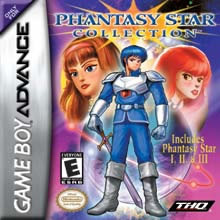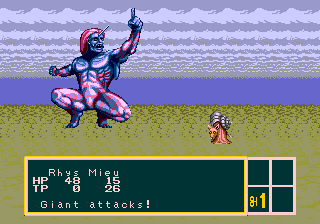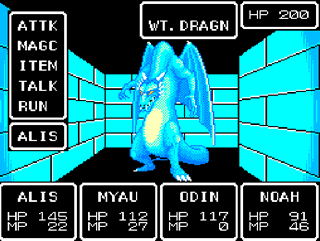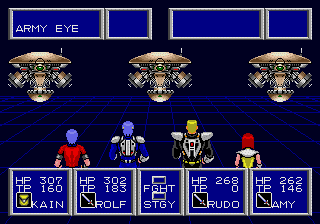Genre: Compilation Developer: Digital Eclipse Publisher: THQ Players: 1 Released: 11/25/02
 Ever since its release back in 1987, Phantasy Star has been at the top of many a gamer’s lists of favorite RPGs and has spawned three sequels, the first two of which have as many detractors as fans (but what do they know?). Part four of the series is considered by most to be the best yet there is love enough for all of them. When it was announced that the games would be making an appearance on the Game Boy Advance, I was understandably elated, as I have purchased all four titles on both the Master System and Genesis, as well as in the incredible Phantasy Star Collection for the Saturn. I was expecting all kinds of goodness on my little handheld and the ability to play them on the go was something to which I was really looking forward.
Ever since its release back in 1987, Phantasy Star has been at the top of many a gamer’s lists of favorite RPGs and has spawned three sequels, the first two of which have as many detractors as fans (but what do they know?). Part four of the series is considered by most to be the best yet there is love enough for all of them. When it was announced that the games would be making an appearance on the Game Boy Advance, I was understandably elated, as I have purchased all four titles on both the Master System and Genesis, as well as in the incredible Phantasy Star Collection for the Saturn. I was expecting all kinds of goodness on my little handheld and the ability to play them on the go was something to which I was really looking forward.
But before any of you get delusions about how much Sega loves you and wants to please all its fans to the best of its ability, I must point out that Sega’s involvement here was minimal at best. This Game Boy Advance compilation wasn’t even released by them but instead by THQ. This was due to a distribution deal worked out by both companies that included the mediocre release of Altered Beast, as well as the abysmal Revenge of Shinobi. Doesn’t seem like the best track record, does it? Thankfully, THQ and their evil minion 3D6 didn’t touch any of the games included in Phantasy Star Collection, leaving instead Digital Eclipse to give us straight-up ports of all three classic titles. I’m quite skeptical as to exactly how much input Sega had, as the quality of this project is less than titillating and virtually nothing was changed (they even used the horrible translations of the original games).
While disappointed, I can’t say that I was surprised when Sega cut the End of the Millennium from the GBA release. The game was huge and probably would have taken up too much space on the cart. The music samples alone ensured that there wasn’t enough memory for another game. What did tick me off was the apparent lack of anything else to take up whatever space was left after the other three games were ported. No art galleries, no scans of any kind, no unlockables. Nothing. Zip. Ziltch. Nada. Digital Eclipse and THQ definitely left their hearts out of this project. Just look at the box art. It’s the perfect poster for how to churn out a quick port. Heck, even the manual had nothing new to offer. In fact, the equipment chart included is laden with misnamed techniques and some magic has even been omitted!
So, with a heavy sigh, I decided that something was better than nothing. Playing the original Phantasy Star on the go was still appealing and I was eager to see how well the games had been ported.
As soon as you boot up the cartridge in your GBA, you get treated to a sight most likely meant to reassure fans of the series. “Created and co-developed by Sega” splashes across your screen, followed by “supervised by Overworks.” It gave me a warm and fuzzy feeling inside knowing that Reiko Kodama was keeping a watchful eye on her babies (along with Tohru Yoshida and End of the Millennium programmer Yoshiaki Endo) and kept me from hyperventilating once the “Game Boy Advance version created by Digital Eclipse” screen reared its ugly head. I, for one, don’t like it when famous and treasured franchises are farmed out to outside developers. True, this is a sometimes fruitful act (Metroid Prime, for example, which is fruity, juicy goodness) but most of the times the final product borders on blasphemous. I’m happy to say that this was not the case here. Phantasy Star Collection has come through foreign hands almost intact and none the worse for wear overall.
The title screen will be instantly recognizable for anyone who’s played the Saturn disc, as will the music. I would like to have thought that this would have been the first of many included upgrades but that’s not the case. Visually, everything here is exactly as you remember it; nothing has changed (insert the above-mentioned zip, ziltch, nada here for added emphasis). The original Phantasy Star still sports its 8-bit looks, which are dated even by GBA standards. I’m sure that purists are wetting themselves with glee that it’s an exact copy but I’m not so sure it’s something to get excited about. To be fair, the 3D dungeons still scroll marvelously and managed to impress me even after all this time. The battle scenes still hold up nicely as well, though it would have been nice to finally see my characters arm or hand during a strike.
The first game isn’t the only one to go practically untouched. Neither of the two sequels include herein sport any graphical improvements either, which may put off potential buyers. As we have seen, the brand alone isn’t enough to sell in huge numbers unless something new and radical is included, as was the case with Phantasy Star Online and while retro may be all the rage, simply tossing three games onto a cart as-is isn’t going to impress a lot of people. Sega was wise enough to revamp the games for the upcoming Sega Ages on Playstation 2, so why not do the same here? I’m sure that the cartridge would have permitted such enhancements, however minimal they may have been. The very least they could have done was eliminate the blue battle grid from Phantasy Star II, which now just looks silly. I refuse to believe that nothing more could have been done with this release.
Not everything is bad graphically, though. The games take quite well to the small screen and look sharper than ever before. Everything is still full screen and details you may have never seen before can now be made out with little effort. These games just flow on the GBA and even the infamously convoluted menu screen from Phantasy Star II is trouble-free.
Things aren’t rosy at all in the sound department, however. I’m a big fan of the music of Phantasy Star and have heard the aural bliss of the remixed and orchestrated versions of the soundtracks, which probably gave me unrealistic expectations about this collection. While the original versions aren’t bad by any stretch of the imagination, I again point to the power of the GBA as the reason for my distaste for their inclusion. Simply listening to the title screen theme should convince anyone that there was room for great improvement here. It’s a sweet and poignant medley of the opening themes to all three titles and is just beautiful. Just be sure to listen to it often, as it’s all you’re going to get. Nothing more has been added to either the music or sound effects, which infuriated meafter getting all excited about that title theme. I guess adapting already existing remixes of the scores as a bonus or in the soundtrack was too much to ask. Digital Eclipse didn’t even do us the courtesy of using the superior Japanese version of the music for the first game. Instead, we get the tinny western version. Yuck.
Even worse, both Phantasy Star II & III are in mono. Why would they downgrade the sound quality? The GBA is capable of stereo sound and since these soundtracks were already in stereo, it makes no sense to change them. Part three of the series suffers the most, as Ippo’s wonderful score has been considerably muffled and sounds little like its console counterpart.
So, the graphics have come through pretty much intact while the music has suffered. How’s the gameplay, you ask? Surprisingly, it’s actually been improved a bit. All three titles now use the same button layout, making the transition between each of them smoother and more intuitive. The run feature so loved in End of the Millennium wasn’t included, though, and I was really hoping that it would have been. Going back to part two after playing it is painfully slow. Incorporating that feature, perhaps through the trigger buttons (both unused), would have been helpful in keeping the series fresh in this era of ADD RPGs that have run as the default setting and even allow you to avoid battles altogether. The slow, methodical, random battle-filled gameplay of the Phantasy Star games might turn off some gamers who aren’t used to its style of play.
Something I thought for sure would be affected by the move to the GBA was the clarity of the on-screen text. Those who had a Master Gear Converter for the Game Gear remember how hard it could be to read text in the first Phantasy Star. Thankfully, this isn’t a problem here. These games were supposedly done from the ground up as opposed to simply being emulated, so I assume that has a lot to do with how well everything looks on the screen. You won’t be squinting to see techniques or items, so breathe easy.
One thing that I did find totally unacceptable was that the GBA version featuresd something the Master System cartridge didn’t: a save crash bug. Originally, Phantasy Star was kind enough to have a save feature that could be used anywhere. You were spared the ungodly trek back to the next boss after having zipped back to town to rest and restock. This can now have serious consequences. Every time you pause to save your game, a window appears warning you not to power off the GBA. However, every so often the “Now Saving” screen will go black or blue and you’ll be forced to reset, losing everything you’ve done up to that point. How this could have made it through testing is beyond me. There’s no reason for a remake to have a bug the original didn’t, especially when said remake has been redone from scratch and is on much more powerful hardware than the original was. The sheer laziness of this collection stands out yet again and it’s a shame that such a simple error should be a blotch on one of my favorite games. Luckily, this bug is isolated to only the original game and both sequels play and save fine. I just don’t understand how something this obvious could have been overlooked.
I know it sounds like I’m being a bit hard on this compilation and that’s not my intent. I can live with all the above-mentioned quirks and complaints, given that the game’s portability cancels them out. The fact that I can whip out my GBA anywhere and play three of the best RPGs ever made is an awesome thought (I wish the strategy guides were so portable!). I have always hoped that these games would someday get a new lease on life and it seems that they have. The unfortunate thing about it is that it appears to be a simple cash run and not a serious effort to bring the franchise into the new millennium.
 Even with the Xerox-tastic ports and crash bug, the inclusion of some unlockable goodies would have made this collection so much better. The first Phantasy Star Collection, released on the Saturn, had video commercials, art galleries, and all sorts of great stuff. I know the ads would have been too much for the GBA but what about some concept or promotional art? How about the Telegenesis text adventure games that only came out in Japan? They gave some great insight about the characters from part two and were never released in the U.S. This would have been the perfect opportunity to bring them out here. My theory is that this release was simply a promotional tie-in to Phantasy Star Online and wasn’t meant to be anything more than that. It is a sad day when the offshoot of a series gets center stage while the original games are farmed out to another company that rushes them out with little fanfare or extras. We saw it with Shinobi for the GBA and I’m sure we’ll see it again when the PS2 version of Altered Beast comes out in Japan.
Even with the Xerox-tastic ports and crash bug, the inclusion of some unlockable goodies would have made this collection so much better. The first Phantasy Star Collection, released on the Saturn, had video commercials, art galleries, and all sorts of great stuff. I know the ads would have been too much for the GBA but what about some concept or promotional art? How about the Telegenesis text adventure games that only came out in Japan? They gave some great insight about the characters from part two and were never released in the U.S. This would have been the perfect opportunity to bring them out here. My theory is that this release was simply a promotional tie-in to Phantasy Star Online and wasn’t meant to be anything more than that. It is a sad day when the offshoot of a series gets center stage while the original games are farmed out to another company that rushes them out with little fanfare or extras. We saw it with Shinobi for the GBA and I’m sure we’ll see it again when the PS2 version of Altered Beast comes out in Japan.
Regardless of THQ and Sega’s attitude, this collection does deserve to be in your GBA. Having the first three games on one cartridge is great and its portability overrides any possible complaint I may have had. You no longer need a Genesis with a Power Base Converter to play the original Phantasy Star and the price of part three alone on eBay is probably more than you’ll pay for this new (I got mine at Toys ‘R Us for a cool $20). These are three classic RPGs that need to be played again by those who experienced them the first time and discovered by those who didn’t. The GBA was made for these types of releases and while it may be a straight port, there’s more than enough adventure here for fans of the genre. So do yourself a favor and take a trip to Algol, your GBA commands it.




Pingback: Phantasy Life: a guide to the Phantasy Star games on Nintendo systems | Nintendo Fun Club Podcast